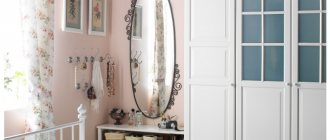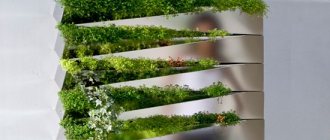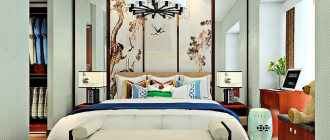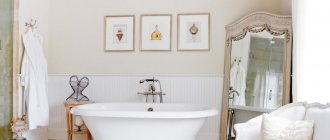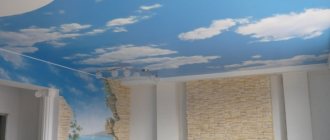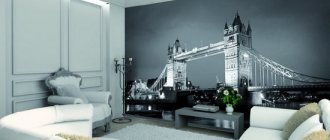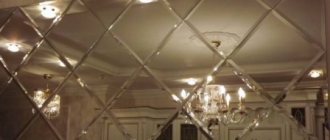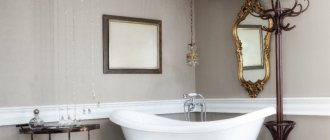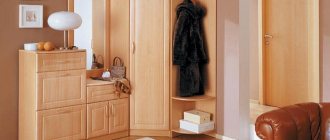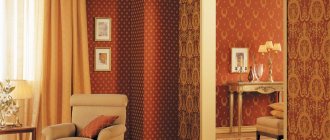A mirror is a special item. It is present in every home, and not in a single copy. Wall decor with a mirror has become a universal and popular technique in the design of many rooms.
Once upon a time, mirrors were generally a luxury available only to a select few. They could be seen in palace corridors, ballrooms or the houses of noble nobles. The mirror design gave the interior an expensive feel and made it elite. Times have changed, mirrors have been transformed, but the theme of decorating walls with mirror elements has not sunk into oblivion - it is still in demand today. Adding decorative mirrors to the decor incredibly transforms the interior - it becomes more luxurious, more elegant, and more impressive.
wall decor with a mirror at the head of the bed
If you think that you will transform a room just by hanging a beautiful mirror on the wall, then you are mistaken. Even the most unusual mirror decoration needs to be able to fit into the decor. Experienced designers are ready to share some secrets on how to get maximum results.
The role of a mirror wall in the interior
Mirror walls in interior design have several functions: visual expansion of space; addition to the interior to improve overall perception; fragmentation of space.
Crushing the reflective surface can greatly change the visual experience of using mirrors in a room.
Most often, designers use mirrors when they want to achieve the effect of visually expanding a room.
With small distances between the elements of the mirror wall, the visual effect of increasing the volume will be most complete.
The use of large mirrors visually changes the dimensions of the space
Less is better
There is one simple postulate for decorating walls with mirrors: the number of mirrors in the space will become smaller as their size increases. For example, one mirror will be quite enough if a person purchased this large-sized product in a mosaic or chic forged frame.
A large, beautiful mirror will fit well into the space if you place it near the kitchen table, above an artificial fireplace, or behind upholstered furniture. There is no need to combine it with other products that have a mirror surface. It will be better if there are no other reflective objects nearby, as this can create a certain imbalance. Compared to other mirrors, the advantages of a luxurious product do not look so effective.
Rules for placing a mirror on the wall
When planning a mirror wall in the bathroom, you need to take into account the operating conditions of this room, as well as its size. The bathroom is, first of all, moisture, condensation, dampness, frequent accidental splashes and a lot of water.
If such a wall has constant contact with water, for example, it is part of the wall of a shower stall, then it should not allow water to pass through.
The reflective design must be waterproof; these are specially produced for baths, baths and saunas
Depending on the quality and chemical composition, tap water, after evaporation, leaves its traces on any surface, which are especially noticeable on such a wall.
Occasional water splashes and condensation should also be taken into account. All together leads to the fact that mirrored walls in the bathroom will become dirty more often than in other rooms.
The bathroom is most often quite cluttered with furniture and plumbing fixtures, which are located at a low height.
A mirrored bathroom looks very impressive
In such cases, it is recommended to place mirrored walls or their elements higher so that most of the furnishings are not reflected in them.
The conditions of the bathroom and kitchen are largely similar. As a rule, these are the same small room sizes. Humidity, temperature changes and rapid contamination of surfaces in the food preparation area. Recommendations for placing such walls in the bathroom and in the dining room are also similar.
It is not recommended to place reflective elements in the cooking and washing areas due to their rapid contamination.
Mirror elements in the kitchen are usually installed in the dining area, at the top of the walls. They try to arrange them in such a way as to minimize the number of furnishings and people in the kitchen reflected in them.
One of the best options for placing such a wall in the kitchen is the side opposite the window.
To add natural light to the kitchen, you can install a mirrored wall opposite the window.
Frame - materials and dimensions
The frame of a mirrored chest of drawers consists of a body, filling, equipment mechanisms and sometimes a table top. The product has the following dimensions, which determine its convenience and spaciousness:
- Height - must be within 70-120 cm, depending on the purpose, so that all the necessary items can be placed;
- Width - basically, 80-100 cm is used relative to the size of the room, so that it is not very heavy and large, but ergonomic;
- Depth – the standard size is 50 cm for better product capacity. A very deep chest of drawers may not look beautiful and be less comfortable to use.
In the next article we will talk about the topic of a bunk bed with a table and a wardrobe. Let's try to describe this topic in more detail.
Wood is considered the most excellent material for the production of a chest of drawers. It has an elegant texture, environmental friendliness and durability. Birch or pine are considered relatively durable species, but over the years they are subject to deformation and are less resistant to wear. Oak, beech, cherry or walnut are much stronger and better, but also cost more.
MDF and chipboard are considered functional and cheap materials. The slabs have increased strength and provide high structural stability. To increase the working properties, the surface of the boards is covered with laminate or veneer. The thickness of medium density fiberboard or chipboard for furniture production is 16, 18 and 30 mm.
The base of the mirrored chest of drawers is made in the form of legs or a base. In the reception area, hallway or bedroom, it is advisable to choose a model with legs. They will give elegance to the design, especially if there are carved components. They must be stronger, up to 15 cm high, so that they can withstand the greater weight of the chest of drawers. The plinth is a front strip that is used as a support or decoration. It performs its supporting function simultaneously with long sidewalls that take up more than half the load. The decorative base very often hides the legs, which have a modest appearance, spoiling the entire design of the product.
Interior made of mirrors
Bedroom
Typically in the bedroom, such surfaces are placed on the ceiling, at the head of the bed, as the back walls of open shelves and as lining of cabinets. Everyone's tastes are different, however, it is generally accepted to avoid placing such walls opposite the head of the bed at the full height of the wall. It is also not recommended to install such surfaces at bed level or below.
Mirror walls in the bedroom interior
Hallway
As for the hallway, it is logical to place mirror elements on the ceiling. Most hallways do not have nearby natural light sources, which is why they often suffer from a lack of light.
This deficiency is compensated with the help of enhanced artificial sources. In such cases, a mirrored ceiling will help improve the illumination of the hallway, more evenly distributing the reflected rays of light from lamps and fixtures.
In the hallway you can make a special finish from reflective materials
Living room
The living room, as a rule, has the largest dimensions in the house, so it is not limited when installing mirrors in small rooms. It is also free from the restrictions of a bedroom and kitchen with a bathroom. It is in the living room that the designer’s imagination can be fully realized.
Mirror tiles in the TV area
Design options
Practicality and conciseness are the main trends in the design of modern interiors. Large rectangular and square mirrors are used for zoning or dividing space. Floor and wall models, decorated with laconic metal frames, ideally complement high-tech and loft furnishings. Minimalism welcomes the use of natural materials, so it is appropriate to choose frames from bleached or tinted wood.
Interiors of mixed styles (pop art, modern, fusion) are decorated with metal, wooden and plastic objects. Decorating a Art Nouveau style room should be done with a mirror of soft, flowing shapes, decorated with a wood molding that is not overloaded with details. As an option - a frame with a wavy pattern. A bright pop art style room will be complemented by an accessory with a metal frame, decorated with small light bulbs. A round canvas framed with a frame with rays is a common, simple decor for the interior of country houses.
When arranging rooms in classical, Victorian, and retro styles, wood products are used. You can recreate the luxury of antique styles with mirrors with heavy massive frames, decorated with elaborate elements, patina, and gilding. Painted wooden frames with an aged look are an integral part of the Provence interior. To decorate a mirror in a country style, thick frames in shades of oak, wenge, and sonoma are suitable. Select accessories of geometrically correct shapes.
Large or medium-sized fashionable mirrors are recommended for the hall to emphasize the stylistic direction of the room and place the necessary accents. You can hang them on the wall, place them on the floor, or even use ceiling panels. In the first case, it is possible to use several mirrors at once, possibly in a chaotic manner. In the bedroom, a reflective sheet should not be placed opposite the bed; the best option is in the corner so that the sleeping person is not visible. For the nursery, you should use wall mirrors of unusual shapes, and for the hallway - a floor model.
Making stylish illuminated mirrors with your own hands, stages of work
High tech
Minimalism
Loft
Pop Art
Modern
Classic
Provence
Country
Varieties
Mirror walls come in the following types:
- Tile.
- Stickers (stickers).
- Facing panels.
- Wallpaper.
Tile
These tiles have different bases. The most common products are based on glass, polystyrene, polyurethane and plastics. All these tiles, with the exception of glass, are usually lightweight and often have a self-adhesive layer.
Glass-based products are heavier and are not recommended for installation on the ceiling.
The reflective surface of the tile can be clean and smooth, or it can have changed geometry, color rendition, and even bear patterns and complex images. An example of modified geometry is the common beveled tile. Typically, such glass-based tiles have beveled edges of a large area; they form a pattern and refract light on their surface.
Mirror tiles, with the exception of glass, are usually lightweight and often have a self-adhesive layer.
Wallpaper
Wallpaper, as a rule, is based on a durable film on which a reflective layer is applied. The reflective layer can have different variations, the same as the tiles. Starting from a solid, smooth mirror to large, complex images printed using photo printing.
Trendy mirror wallpapers look interesting
Such wallpapers are heavier than paper ones, so not every adhesive is suitable for them.
Also, such wallpapers often have a high reflectivity of radio waves. In other words, mobile phones in a room with this wallpaper may have poor signal reception.
Stickers
Decals or stickers are used as reflective design elements. There is simply a huge variety of such stickers on the market with different bases, shapes and applications. For example, a sticker on a thin film base is most often used for gluing furniture and even, smooth surfaces.
Wave Stereoscopic Mirror Wall Sticker
Cladding panels
By facing mirror panels it is correct to understand large, durable and heavy finishing elements. As a rule, they are made of thick tempered glass or acrylic. The heaviest cladding panels are most often used in places where large mechanical loads are expected. However, there are also lighter and smaller options, such as ceiling or wall panels.
Mirror panels on a self-adhesive basis
Creating mirror compositions
Wall accessories are the most popular type of decor. There is an easy way to change the design of a room - experimenting with a group of elements. Original ideas:
- Use original round mirrors in the interior, which bring notes of relaxation and comfort. It is worth choosing products decorated with textured frames to match the decor. Hang the elements randomly or in a certain order. You can also use mirror circles of different diameters. A creative solution is to place round elements in square frames and fix them at the same level.
- To visually expand a narrow, high room, use a group of oval, rectangular accessories (place the long sides horizontally).
- To make the mirror composition look dynamic, combine elements of different shapes or arrange large and small objects chaotically.
- A rectangular composition made up of square elements is an extraordinary design for a wall above a bed or in a hallway.
- Place an ensemble of 3-4 long mirrored rectangles above the table in the living room or dining room.
To hang a mirror on the wall of a room, you can use hidden fasteners or simple laces.
If there are small children, small elements are placed under the main large mirror so that they can also see themselves well. To make the composition look harmonious, the details are united by some element or feature. Alternatively, select products of the same shape, with frames of a similar shade or the same texture/texture, material. Antique or vintage frames are a great opportunity to create a mirror gallery collection.
Step-by-step creation of a frame for a mirror with your own hands, decor options
Six decor options
Mirror panels for cabinets and bars
One of the popular options for using reflective elements is furniture decor - cabinets and bedside tables. Such decorations can be roughly divided into several types. The first option for decorating from mirrors is quite standard - the back and side panels of the inside of cabinets, sideboards, and bars.
Mirrored wardrobe
Complete decoration of furniture
The second option is to decorate the furniture externally with large solid mirror elements; more often, glass stickers based on a thin film are used as such elements.
Mirror sliding doors for wardrobes mirror bronze
Reflective elements
The third option is small external mirror elements.
Mirror elements in furniture
Panel
Another option for using mirror elements in decor is a panel. This design element consists of a large number of individual mirrors that combine to form a complete picture, and can vary greatly in shape, appearance and size.
In today's modern world, mirror exhibitions have become quite popular.
Mirror honeycomb finish
A beautiful option is honeycombs.
Mirror mosaic rhombuses 3x2cm
Use of arches and niches
Arches and niches are decorated with mirror panels, stickers or wallpaper. If in the case of an arch there are no strong restrictions, then it is better to leave the decorative niches empty or sparsely filled. Both arches and niches are rarely decorated with simple mirror elements. Most often, various patterns and designs are used in mirrored decorative elements intended for arches and niches.
Mirror panel with facet in the interior
In conclusion, we can say that today mirror-based finishing and design elements are presented on the market in a wide range. There is a wide choice for every taste and budget. Well, such walls and other decorative elements made from mirrors themselves can greatly change the appearance of the house, giving additional comfort and coziness.
Specifications of a chest of drawers with a mirror finish
A mirrored chest of drawers belongs to one of the varieties of mirrored furniture and has a number of interesting properties. Mirrors are usually located on the facade or on the entire body, creating a very beautiful look. Due to the fact that they reflect the light and space around them, chests of drawers are able to visually expand the room, simulating the spaciousness of the room.
In the next article we will talk about the topic - sink and bedside table. Let's try to describe this topic in more detail.
Mirrors are plates made of glass or very durable plastic, which are covered with a reflective layer of specific materials:
- Aluminum - a metal layer is applied to the base with the addition of varnish for protection, copper and adhesive. This ensures a clean and reliable mirror surface with excellent reflective properties.
- Silver - the production process is similar, only the metal layer is changed to silver. This mirror can be made in many different shapes and sizes.
In the form of decoration, spraying of various colors, abrasions, stencil paintings, and also aging with craquelure are used. The decor can be located over the entire surface, occupying the contours or corners of the mirror, creating an original appearance or effect relative to the design style.
Mirror plates are attached to the chest of drawers in three ways: with double-sided tape, using liquid nails or sanitary silicone. The base and back side of the plates are degreased, then strips of tape or silicone are applied to the mirror, and it is applied to the base in the required position with the addition of a press. A press is needed for tight contact of surfaces and good adhesion of fastening agents.

